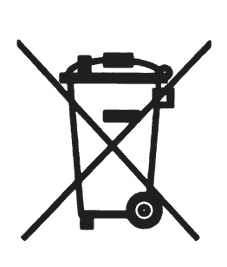Electrical and electronic equipment - information for private households
The Electrical and Electronic Equipment Act (ElektroG) contains a large number of requirements for the handling of electrical and electronic equipment. The most important ones are summarised here.
1 Separate collection of old equipment
Electrical and electronic equipment that has become waste is referred to as old equipment. Owners of WEEE must dispose of it separately from unsorted municipal waste. In particular, WEEE should not be disposed of with household waste, but should be taken to special collection and return systems. 2.
2 Batteries and rechargeable batteries as well as lamps
Owners of WEEE must, as a rule, separate spent batteries and accumulators that are not enclosed in the WEEE, as well as lamps that can be removed from the WEEE without causing damage, from the WEEE before handing them over to a collection point. This does not apply if WEEE is prepared for re-use with the participation of a public waste management authority.
3 Options for the return of WEEE
Owners of WEEE from private households can return it to the collection points of the public waste management authorities or to the collection points set up by manufacturers or distributors in accordance with the ElektroG. An online list of collection and take-back points can be found here: https://www.ear-system.de/ear-verzeichnis/sammel-und-ruecknahmestellen.jsf or here: https://www.take-e-back.de
Shops with a sales area of at least 400 m² for electrical and electronic equipment as well as those grocery stores with a total sales area of at least 800 m² which offer electrical and electronic equipment several times a year or on a permanent basis and make it available on the market are obliged to take it back. This also applies to sales using means of distance communication if the storage and dispatch areas for electrical and electronic equipment amount to at least 400 m² or the total storage and dispatch areas amount to at least 800 m². Distributors of distance selling who are obliged to take back electrical and electronic equipment shall, in principle, ensure take-back by providing suitable return facilities at a reasonable distance from the respective end-user.
The possibility of returning an old appliance free of charge exists for distributors who are obliged to take it back, inter alia, if a new appliance of the same type, which essentially fulfils the same functions, is supplied to an end user. If a new appliance is delivered to a private household, the similar waste appliance may also be handed over there for collection free of charge; this applies in the case of distribution by means of distance communication to appliances falling into categories 1, 2 or 4 pursuant to Section 2(1) of the ElektroG, namely "heat transmitters", "display screen equipment" or "large appliances" (the latter with at least one external dimension exceeding 50 centimetres). End-users are asked about their intention to return such equipment when they conclude a purchase contract. In addition, it is possible to return such waste equipment, which does not exceed 25 centimetres in any external dimension, to the collection points of the distributors free of charge, irrespective of the purchase of a new device, and this is limited to three waste devices per type of device.
4. data protection notice
Old equipment often contains sensitive personal data. This applies in particular to information and telecommunications technology devices such as computers and smartphones. In your own interest, please note that each end user is responsible for deleting the data on the end-of-life devices to be disposed of.
Meaning of the symbol "crossed-out dustbin"
 The symbol of a crossed-out dustbin regularly displayed on electrical and electronic equipment indicates that the respective device must be collected separately from unsorted municipal waste at the end of its service life.
The symbol of a crossed-out dustbin regularly displayed on electrical and electronic equipment indicates that the respective device must be collected separately from unsorted municipal waste at the end of its service life.
6. note on waste prevention
According to the provisions of Directive 2008/98/EU on waste and its implementation in the legislation of the Member States of the European Union, waste prevention measures generally take precedence over waste management measures. In the case of electrical and electronic equipment, waste prevention measures include, in particular, extending the life of the equipment by repairing defective equipment and disposing of used equipment in good working order instead of sending it for disposal. Further information can be found in the waste prevention programme of the Federal Government with the participation of the Länder: https://www.bmu.de/publikation/abfallvermeidungsprogramm-des-bundes-unter-beteiligung-der-laender/.
7. further information
We are a member of the take-back system "take-e-back". For more information, visit www.take-e-back.de.
